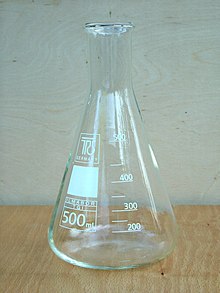Flask
A flask is a type of container made of glass. They are a common piece of apparatus used in laboratories. Their size are chosen by the volume they can hold, and is measured in metric units, like litres (L) or millilitres (mL). Their shape depends on what they are used for, but they usually consist of a wider body, which contains the materials, and a more narrow neck with an opening at the top. The opening is the way to insert materials into the body. Some flasks have more than one neck and opening at the top.

Flasks are used to contain substances. They are usually made of glass or borosilicate glass (Pyrex). This is to ensure that the substances inside the flask do not react with the flask itself, due to the volatile nature of many chemicals (such as hydrochloric acid), They can be used to heat a substance. There are many different types of laboratory flasks. They differ in their shape and what they are used for. The most common types of flask are:
Flasks can be used to make and hold solutions, to measure chemicals, and to contain chemical reactions like boiling, precipitation and analysis.
-
Round-bottom flask—a flask with a round body and one or more necks with ground glass joints.
-
Retort—a round vessel with a long downward-pointing neck.
-
Florence flask—a flask with a round body and one longer neck without a ground glass joint.
-
Büchner flask or sidearm flask—a flask with thick walls and a short tube for connection of a hose on the side of its neck.
-
Volumetric flask—a flask used for preparing liquids in very precise volumes. It is a flask with a pear-shaped body and a long neck with a line on it which marks the standard volume it can contain.
-
Dewar flask—a flask with which is used to hold a vacuum.





